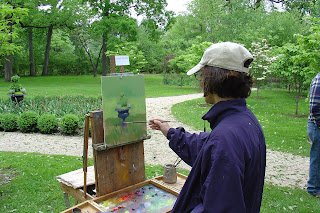

Well it has been a little while since I participated in the Cranford Artist Studio Tour and it would be remiss of me not to chat about my experience! I must say I had an awesome time! Many cheerful and supportive patrons of the arts poured out onto the streets to check out what Cranford had to offer. The drizzly rain did not hinder the fans of the fine arts nor we visiting plein air painters! Myself and Eleinne Basa were the plein air painters demonstrating plein air painting techniques, explaining about the easels we used, the colors on our palettes, and explaining exactly what is plein air painting, etc. I was absolutely delighted to meet the public and to meet fellow artists. I was extremely touched by the support of my students who showed up and remained with me for the entirety of the event. There was an energy that was positive and supportive and the buzz that was created from this event left me feeling very happy. I would like to recognize Deborah Leber and Paul Casale for inviting me to participate in the Cranford Artist Studio Tour. They did a fabulous professional job and I thank them so much for offering this opportunity to me! I would also like to recognize the super team of volunteers who were so helpful and polite to us visiting plein air artists. They set up a wonderful sheltered area for Eleinne and myself to display our work and to retreat to from the rain. Many many thanks! I wish them the best of success in launching their vision of locating a building in downtown Cranford to house artist working studios. Their hope is to have such a place for artists to work, sell, teach and interact with each other. This is for many artists a dream and I hope they succeed! Cheers JCAS!
Nice work and blog Diana. I was also at the JCAS tour in May. I was painting at Simply gallery. Maybe we'll meet at the next Cranford event. I hear they are doing a plein air event.
ReplyDeleteSteve